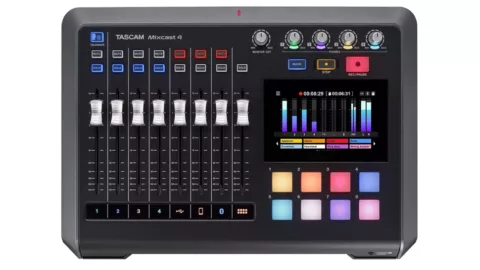The New TASCAM MIXCAST 4 Podcast Station ; modern-day Portastudio
The Tascam Mixcast 4 Podcast Workstation looks like a modern-day Portastudio; – a home recording studio for the internet generation.
The new Mixcast 4 is designed not just for podcast creation but also live streaming, event production and voiceover work, this enables you to mix and record multiple audio sources to SD card, and comes with its own companion software editing app so that you don’t have to go anywhere near a DAW.
There are four TRS/XLR combo jack mic inputs and four headphone outputs – ideal for roundtable podcasts with multiple participants. Auto-mixing functionality means that levels are set for you, and a 5-inch colour touchscreen enables you to dive into menus and adjust settings.
In addition, there are eight customizable sound pads that can be used to trigger preset effects and sounds, so that you can add interest to your recordings. The Mixcast 4 also functions as a 14-in/2-out USB audio interface, while Bluetooth connectivity makes it easy for you to record phone calls or background music from paired devices.
You can also plug your phone in via one of the four stereo line inputs, which can accept instruments, too. Other connectivity options include a front top panel 3.5mm TRRS headphone out that can mirror the output of headphone 1, stereo 1/4-inch TRS main monitor outputs and a 3.5mm stereo line out.
The companion Tascam Podcast Editor software, meanwhile, is designed to offer simple audio editing, track arming, and the ability to configure and assign sound effects and background music to the pads. It promises full integration with the Mixcast 4 hardware, and runs on Windows, macOS and iOS. An Android version is in the works, too.
The Tascam Mixcast 4 Podcast Station is now available. Find out more on the Tascam website.



